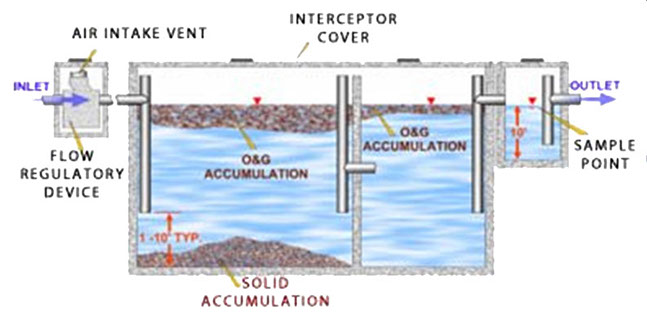Grease Trap Cleaning
If you have a grease trap, it will need cleaning. Grease traps are very important. They prevent blockages by trapping the greases from sinks and waste water from entering the water supply as it enters the sewer lines. For them to work properly, they must be cleaned regularly. How regular depends on several factors.
Environmental Specialists are the experts!
Let the pros handle your grease trap cleaning. We take all grease to a recycling facility. With our Regular Maintenance Program you can forget about your grease trap maintenance! Environmental Specialists will keep track of when you need a cleaning. And by letting us handle it, you can save money. Contact us today and find out how much you can save.
Grease Traps
A grease interceptor removes fats, oils, and grease (FOGS) that coat city sewer lines and cause sewer overflows. If an overflow occurs, you may be responsible for clean-up costs and property damage.
How does a large outside grease interceptor (trap) work?
A standard grease interceptor (trap) is large capacity underground vault generally with two compartments (chambers) separated by a baffle accessed by two manhole lids. The purpose of a grease trap is to prevent grease and food solids (FOGS) from entering the sanitary sewer system where it can cause expensive clogs.
It accomplishes this by capturing all of the waste deposited in the drains, triple sinks and dishwasher in the grease trap. Wastewater enters the interceptor unit after leaving the kitchen. As the waste cools the grease floats to the top and food solids settle to the bottom of the first chamber of the unit (see diagram). Water flows into the second chamber where more solids and grease separate out. The remaining water then flows out of the interceptor unit and into the city sewer lines.
It should be noted that a functioning grease trap should always maintain a full liquid level. This does not indicate that the trap is full of grease. A functioning grease trap should be filled to the normal liquid level with a combination of water, grease and food solids.
How does an inside grease trap work?
A grease trap is a small reservoir or steel box either in the floor or near the grease producing area, usually near the triple sink. They range in size from 15-50 gallon, occasionally up to 300 gallons.

DNR Code Compliance
© 2016 Environmental Specialists All Rights Reserved.
